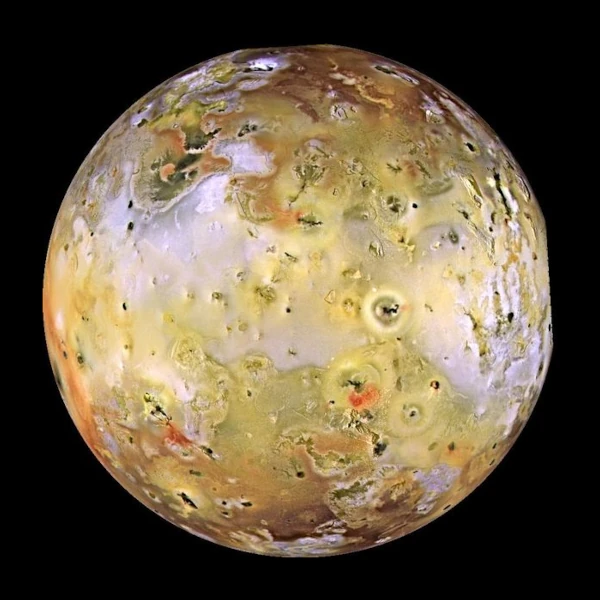
Io, Jupiter’s third-largest moon (diameter: 3,643 km), is the most geologically active body in the solar system. Discovered in 1610 by Galileo Galilei (1564-1642) along with the other Galilean moons, Io exhibits unique features:
Io is in orbital resonance with Europa and Ganymede (1:2:4 ratio), amplifying tidal forces and explaining its extreme geological activity.
Data from the Galileo (1995-2003) and Juno (since 2016) missions have established a detailed model of Io’s internal structure:
Surface composition is dominated by:
Io is covered with over 100 mountains (some taller than Everest) and more than 400 active volcanoes. Eruptions are primarily of two types:
| Eruption Type | Main Characteristics | Temperature (°C) | Typical Example | Characteristic Duration |
|---|---|---|---|---|
| Effusive eruptions | Basaltic lava flows | 1,200-1,400 | Prometheus (6,000 km² of flows) | Years to decades |
| Explosive eruptions | SO₂ plumes up to 500 km high | >1,600 | Pele (permanent plume) | Hours to months |
The average eruption rate is 104 kg/s, 100 times higher than on Earth. Hotspots can reach 1,600°C (detected in infrared by Galileo).
Io’s thermal energy primarily comes from:
Thermal models show this heating maintains a partially molten asthenosphere at 50-100 km depth, the source of magmatism.
N.B.:
The asthenosphere of Io, Jupiter’s volcanic moon, is a hot, ductile layer of the inner mantle, partially melted by strong tidal forces from Jupiter. It enables rapid recycling of the volcanic crust and fuels Io’s intense surface volcanic activity.
Io has a very thin atmosphere (pressure: 10-8-10-7 bar), mainly composed of:
This atmosphere is in dynamic equilibrium with:
Io loses about 1 ton/second of atmospheric material, forming a plasma torus around Jupiter (discovered by Voyager 1 in 1979).
Io’s plasma torus is a complex structure interacting with Jupiter’s magnetosphere:
This torus is responsible for:
Juno observations (2016-present) revealed Alfvén waves in the torus, suggesting complex interactions between Io and Jupiter’s magnetosphere (Sulaiman et al., 2021).
| Mission | Agency | Period | Key Discoveries | Minimum Distance |
|---|---|---|---|---|
| Pioneer 10 & 11 | NASA | 1973-1974 | First distant images, detection of unusual activity | 300,000 km |
| Voyager 1 & 2 | NASA | 1979 | Discovery of active volcanoes, plasma torus, global mapping | 20,600 km |
| Galileo | NASA | 1995-2003 | Detailed study of volcanoes, surface composition, internal structure | 181 km |
| New Horizons | NASA | 2007 | Observations of volcanic plumes during Pluto flyby | 2,500,000 km |
| Juno | NASA | 2016-2025 | Study of magnetospheric interactions, infrared volcano observations | Varies (polar orbits) |
| Io Volcano Observer (proposed) | NASA | 2029 (planned) | Mission dedicated to volcano and plasma torus study | 100 km (planned) |
Several of Io’s volcanoes are particularly studied for their activity and structure:
| Volcano | Type | Temperature (°C) | Main Characteristics | Particularities |
|---|---|---|---|---|
| Pele | Dome volcano with lava lake | 1,600 | Plume 300-500 km high (SO₂) | Continuous activity since 1979 |
| Loki Patera | Basaltic lava lake | Variable | Surface area 21,500 km² (larger than Lake Ontario) | 540-day eruption cycle, observed lava waves |
| Prometheus | Lava flows and plume | ~1,300 | Flows >1,000 km, plume 75-100 km high | Stable activity since 1979 |
| Tvashtar | Explosive volcano | 1,450 | 330 km plume (2007 eruption) | Rapid morphological changes |
| Masubi | Effusive volcano | 1,300 | 500 km long flows | Source of particularly high heat flow |
Several future missions will deepen our understanding of Io:
Major scientific questions for the coming decades include:
| Characteristic | Io | Earth | Venus | Enceladus | Triton |
|---|---|---|---|---|---|
| Number of active volcanoes | >400 | ~1,500 | ~1,600 | Cryovolcanoes (uncertain) | Geysers (active) |
| Max. eruption temperature (°C) | 1,600 | 1,200 | 1,100 | -100 (cryomagma) | -200 (liquid nitrogen) |
| Main lava composition | Basalt + sulfur | Basalt, andesite | Basalt | Water + salts | Nitrogen + dust |
| Heat flow (W/m²) | 2.5 | 0.087 | 0.065 | 0.005 (estimated) | 0.002 (estimated) |
| Primary energy source | Tidal forces | Internal heat + radioactivity | Residual heat | Tidal forces | Residual heat |
| Dominant activity type | Effusive + explosive | Effusive (70%) | Explosive (90%) | Cryovolcanism | Geysers |